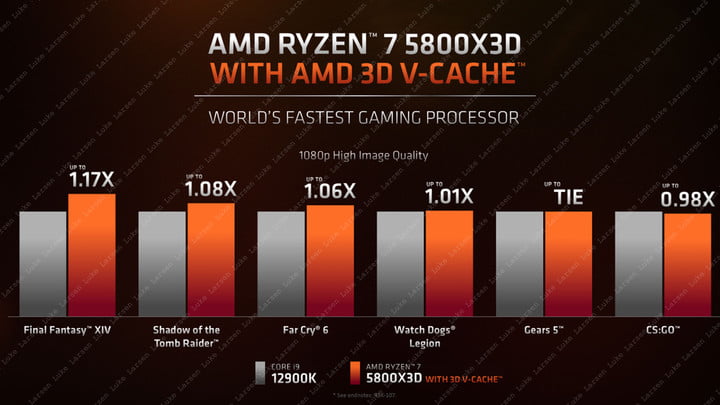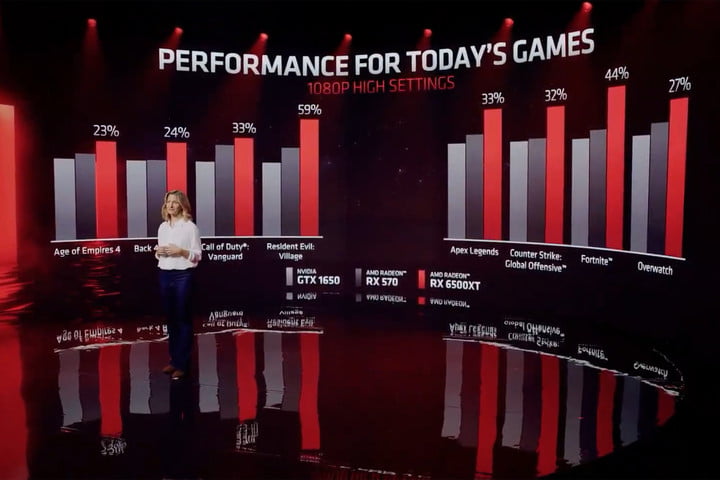AMD’s CES 2022 keynote speech kicked off the year’s biggest tech show with a bang. With Nvidia and Intel firmly in its sights, AMD brought the big guns to bear and debuted new 3D VCache gaming processors, expanded Radeon 6000M and 6000S mobile graphics, a new 6500 XT graphics card, and a massive expansion of AMD’s FidelityFX Super Resolution technology.
There was even a sneak peak of what AMD’s upcoming Zen 4 CPUs will be capable of.
Here’s everything AMD announced at CES 2022.
Ryzen 3D VCache CPUs

AMD hasn’t said much about its new cache technology since it originally teased it in the middle of 2021. However, following the stellar success of Intel’s new Alder Lake processors, AMD needs something to tide it over until Zen 4 debuts later this year. That’s 3D VCache, and it’s coming to a refreshed line of Ryzen 5000 processors in the spring in the form of a new chip: The Ryzen 7 5800X3D. AMD calls it the world’s fastest gaming processor.
The technology effectively involves stacking a whole new level of cache of top of existing CPU designs, giving them as much as triple the L3 cache. Considering how much Ryzen processors love extra memory bandwidth, the extra onboard cache goes a long way in improving performance, particularly in gaming.
AMD claims that this design change alone will make the new 5800X3D as much as 36% faster than the previous AMD gaming king, the 5900X, but notably faster than Intel 12900K in some games, too. That’s a huge performance jump considering the traditional 5800X was previously more competitive with the 12600K.

Although these performance jumps aren’t revolutionary, they are a big intergeneration evolution of the Ryzen 5000 range, which already holds its own against even Intel’s hot new Alder Lake processors.
It should be enough to give AMD a performance edge in some games while we await its next-generation Zen 4 designs later this year.
Ryzen 7000 Zen 4 CPUs preview
AMD ended its announcement with its most anticipated product. Ryzen 7000 processors based on AMD’s new Zen 4 architecture will be the most significant CPU release since the original Ryzen processors debuted in 2017. It marks the end of AMD’s long-standing AM4 socket, a change to land grid array (LGA) rather than pin grid array (PGA) — where the pins are in the socket, rather than on the chip — and added support for DD5 memory and PCI Express 5. On top of that, the processors themselves will move down to the smaller TSMC 5nm process node, from the 7nm node that’s been in use since Ryzen 3000 processors. The whole architecture has been redesigned to deliver unprecedented performance.
Although we’ll need to wait until later this year to see more concrete evidence of how well these new chips perform, AMD did showcase an exciting example of just how fast they’ll be. In a live demonstration of a Ryzen 7000 CPU running Halo Infinite, AMD confirmed the CPU’s cores all running at 5GHz. That’s a first for stock AMD desktop CPUs, and shows that AMD is continuing to push the boundaries of what its processors can do.
New RX 6000M and 6000S GPUs
AMD’s RDNA 2, RX 6000 graphics cards have proved hotly competitive with Nvidia’s best on both desktop and mobile, but the whole range has felt a little limited in terms of options. AMD is now expanding its 6000M range of mobile GPUs with new top-tier, midrange, and entry-level GPUs. The RX 6850M XT at the top end is 7% faster than the existing 6800M, while the 6650M XT and 6650M offer up to a 20% performance improvement over the 6600M.
AMD is also introducing new 6500M and 6300M mobile GPUs, which offer excellent competition for Nvidia’s entry-level mobile graphics chips by reportedly more than doubling performance over the popular MX 450.
Expanding AMD’s graphics card lines further is a new 6000S series of GPUs that are designed to drive high-performance gaming in thinner and lighter gaming laptops.

These include the 6800S, 6700S, and 6600S. AMD wasn’t forthcoming about the raw performance numbers of these GPUs, but claims that they should be able to deliver 100 frames per second (fps) at max settings at the top end, and over 80 fps at high-settings at the more modest end. Resolutions and specific games weren’t shared, so it’ll be interesting to see just what this new range of power-efficient GPUs will be capable of — especially if paired with AMD’s new Ryzen 6000 series mobile processors.
Ryzen 6000 Mobile CPUs

With Ryzen 5000 getting a 3D VCache refresh on the desktop, laptops are getting a lot of love in 2022 as well, but in a very different way. The new range of Ryzen 6000 mobile processors will launch with new laptops starting in February, and will feature a new Zen 3+ core design based on TSMC’s 6nm process, RDNA 2 onboard graphics, DDR5 and LPDDR5 memory, and support for Wi-Fi 6e and USB 4 technologies.
The new Zen 3+ cores can reach up to 5GHz, leading to an impressive 30% performance increase in raw CPU performance, and AMD claims the onboard RDNA 2 GPU offers as much as a 100% uplift in graphical performance over previous Vega designs. This can allegedly deliver a real-world performance increase of 100% in some games with a Ryzen 7 6800U, versus the previous-generation 5800U, and more than double the performance in 3D rendering.

The onboard GPU is allegedly capable of outperforming not only Intel’s best onboard graphics, but also low-level Nvidia dedicated GPUs, like the MX450. Although you’ll still want a dedicated graphics chip for higher-detail gaming, AMD laptops sporting the new 6000-series APUs should be fantastically affordable gaming machines, without the need for a dedicated GPU. That opens up the potential for even thinner and lighter gaming laptop designs.
AMD also laid claim to these being the first APUs that can perform hardware-accelerated ray tracing without any need for a dedicated GPU. Although there aren’t many games that’ll offer good frame rates with ray tracing with onboard graphics, the fact that the CPU can even run it at all is impressive.
Battery efficiency is also said to be far greater with this generation, making it possible to run AMD laptops for up to 24 hours on a single charge for the first time.
As with all major announcements, we’ll need to see real-world performance from third parties before taking any of this as gospel, but AMD promised at least 20 upcoming designs from major manufacturers in the near future, so watch this space for upcoming Digital Trends reviews of many of these exciting new laptops.
RX 6500 XT desktop graphics

Back in the desktop arena, AMD also announced a new class of entry-level gaming graphics card, the 6500 XT. This expands the existing RX 6000 range of GPUs with a more affordable and accessible 1080p GPU. Designed to replace aging designs like the RX 570 and 580, and compete with Nvidia’s entry-level GTX 16-series cards, the 6500 XT will reportedly deliver above 60 fps at high-settings in most modern AAA games.

It does this with an unprecedented 2.6GHz game clock speed, and is built on the 6nm process node, helping it deliver impressive performance in a compact and affordable GPU.
The 6500 XT goes on sale on January 19, starting at $199.
Radeon Super Resolution

Radeon Super Resolution is an evolution of AMD’s existing FidelityFX Super Resolution technology. Set to debut in an upcoming driver release in the first few months of 2022, it will let users apply FSR-like upscaling to thousands of games. You’ll be able to adjust the resolution down in-game, and FSR will be automatically applied to improve visual fidelity while letting you take advantage of the performance enhancement of rendering at a lower resolution.
This could be a huge boon to those playing with older-generation AMD and Nvidia graphics cards, which can’t make use of Nvidia’s more capable deep learning super sampling (DLSS), or simply can’t run some modern games because their GPU just isn’t fast enough. FSR has proved a capable upscaling technology for improving performance and bringing it to an exhaustive range of games, and it could have a huge impact on gaming performance for everyone.
